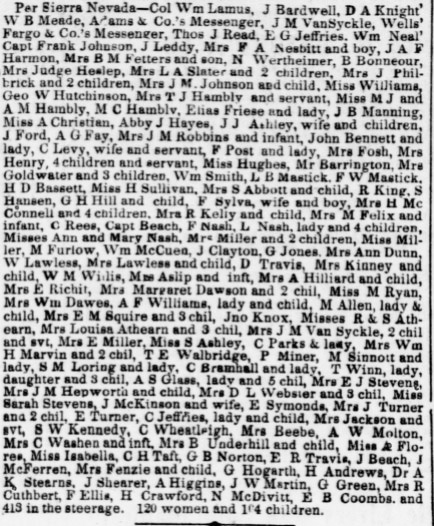Passenger Lists: San Francisco 1800s

SS Sierra Nevada
Arrive San Francisco
AJuly 2, 1854
Captain James H. Blethen
From San Juan del Sud, Nicaragua
Passage
July 2, 1854, Daily Alta California, San Francisco
Arrival of the Sierra Nevada
The Revolution in Nicaragua
The Nicaragua Co.'s steamship Sierra Nevada, arrived at 2 o'clock this morning, with 700 passengers, among whom it will be seen is the large number of 120 women and 104 children.
We are indebted to Purser Foster, for the subjoined memoranda and list of passengers:
MEMORANDA.
Steamer Sierra Nevada, James H. Blethen, commander, left San Francisco, June 1, with over 600 passengers, and arrived at San Juan in 11-1/2 days. The passengers, specie, and great independent mails arrived at the Atlantic steamer on the 13th day from San Francisco.
Left San Juan on the morning of June 20, and arrived at this port July 1, in 11-1/2 days, bringing upwards of 7OO passengers, all in good health, among which are 120 women and 104 children. The S. N. has experienced fine weather during the upward trip, with the exception of two days of northwesterly gales, with heavy head rolling seas.
The revolution in Nicaragua is nearly concluded. The revolutionists under Castellon having possession of every town in the State, except Granada, (the strong hold of the old regime) which they held closely besieged, and could undoubtedly be taken at will, but for their desire to prevent bloodshed. The conflict thus far has been almost entirely bloodless, and the new party is very generally received with extreme favor by both the native and foreign residents.
Passengers

Immigration at the Golden Gate: Passenger Ships, Exclusion, and Angel Island
Robert Eric Barde
Perhaps 200,000 immigrants passed through the Angel Island Immigration Station during its lifetime, a tiny number compared to the 17 million who entered through New York's Ellis Island.
Nonetheless, Angel Island's place in the consciousness of Americans on the West Coast is large and out of proportion to the numerical record. Angel Island's Immigration Station was not, as some have called it, the Ellis Island of the West, built to facilitate the processing and entry of those welcomed as new Americans. Its role was less benign: to facilitate the exclusion of Asians, starting with the Chinese, then Japanese, Koreans, Indians, and all other Asians.
The Children of Chinatown: Growing Up Chinese American in San Francisco, 1850-1920
Wendy Rouse Jorae
Family Skeletons: Exploring the Lives of our Disreputable Ancestors.
Simon Fowler, Ruth Paley
Most families have a skeleton. You may have already discovered yours via the grapevine or your own research. Or you may simply be intrigued by the dark side of our past. This popular history explores the behaviour of our disreputable ancestors from the unfortunate to the criminal, and introduces a host of colourful characters including 17th century witches, 18th century 'mollies' and Victorian baby farmers. Thematically arranged by skeleton, the text also describes how society punished and provided for its 'offenders' - as well as the changing attitudes that could ultimately bring acceptance.
Italy on the Pacific: San Francisco's Italian Americans (Italian and Italian American Studies)
Palgrave Hardcover)
Sebastian Fichera
San Francisco’s Italian immigrant experience is shown to be the polar opposite of Chicago’s. San Francisco’s Italian immigrants are shown as reintegrating into the host society fairly smoothly, whereas the Chicago group’s assimilation process broke down in dramatic ways.

(Themes in World History)
Patrick Manning
Drawing on examples from a wide range of geographical regions and thematic areas, noted world historian Patrick Manning guides the reader through trade patterns, including the early Silk Road and maritime trade, effect of migration on empire and industry, earliest human migrations, major language groups, various leading theories around migration.
Russian San Francisco (Images of America) (Images of America)
Lydia B. Zaverukha, Nina Bogdan, Foreward by Ludmila Ershova, PhD.
Even before San Francisco was founded as a city, Russian visitors, explorers, and scientists sailed to the area and made contact with both the indigenous people and representatives of the Spanish government. Although the Russian commercial colony of Fort Ross closed in 1842, the Russian presence in San Francisco continued and the community expanded to include churches, societies, businesses, and newspapers. Some came seeking opportunity, while others were fleeing religious or political persecution.










 Copyright ~ 1998-2018.
Copyright ~ 1998-2018. 